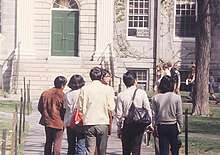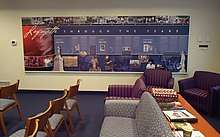College tour
A college tour, also called a campus tour, is a tour of a college or university's campus. Prospective students, their family members and other visitors take campus tours to learn about the college or university's facilities, as well as student life, culture on campus, academics, and programs offered by the institution. During these tours, prospective students are able to learn about the built environment and the overall look and feel of the institution. Campus tours are usually free, as they promote the institution and encourage prospective students to attend the school. Often, schools may give visitors T-shirts or other gifts for taking a tour.
In the collective sense, a college tour may comprise a series of campus visits to a number of colleges or universities. The institutions visited may be two or four year programs and the prospective student may be a freshman, transfer, or graduate student. College tours may be taken individually or by school groups and educational programs as a way for many people to visit several schools over a short period of time. In addition, many colleges now offer virtual tours on the Internet.
Campus visit

A college tour is composed of multiple, distinct campus visits. In most cases a campus visit involves an information session directed by an admissions officer and a walking tour of campus conducted by a student ambassador.[1] A campus visit can be taken by individual students and their families, with the student and parents often joining other individuals to create a larger group. Many colleges offer “open houses” usually consisting of a day or series of days set aside for students and their families to visit a particular school. Often there will be special programs or presentations during these times which would not be available during a regular visit.[2][3] Most colleges and universities also offer private tours and information sessions for large groups from a single school or educational program.[4][5]
For prospective students, a tour may be part of a larger campus visitation program. Some schools provide overnight accommodation and meals, and students may sit-in on a class during their visit. Some programs pair a prospective student with a current student and allow the prospective student to shadow the current student for a day.
Counselors and admissions officers often urge students to visit colleges before applying. Students often use their observations from college visits to make a final selection.
College tours are usually planned 2 to 4 weeks in advance and more for larger schools.[6] Students are encouraged to plan their visit during the school year when classes are in session to get a true sense campus life.[7][8][9] A family campus visit can be arranged by calling the school's visitor center or admissions office. Many colleges allow students to register for their college tour on the campus website. Group campus tours are planned by high school counselors, parent-teacher associations, and educational programs such as Boys and Girls Club of America or Upward Bound. Tour operators also offer paid services to plan and arrange college tours for groups in addition to transportation, lodging and activities.
Information session
An admissions information session provides prospective students with knowledge about the college they are applying to. These sessions usually last thirty minutes to an hour and include information about admissions requirements, financial aid, and academic requirements for acceptance to that particular institution.[10][11]
Campus tour
These tours are normally walking tours for groups of 10 to 30 visitors, led by a tour guide. Campus tours are often preceded by an information session, presented by a member of the admissions staff. Many campus tours include a visit to a residence hall room and a classroom or lecture hall. At most schools, tours are led by students, although admissions office staff or other representatives of the school may also be tour guides. Most universities offer accommodations for students with disabilities, such as alternatives to walking for someone who cannot walk easily.
The walking campus tour allows students to see the campus including academic buildings, residence halls, dining halls, athletic fields, and other areas. Some tours offer students a glimpse into a dorm or classroom but this varies from campus to campus. Walking tours are usually conducted by a current student ambassador who, in addition to pointing out campus highlights, answers student questions.[12][13]
Sample campus visit

| Time | Activities |
|---|---|
| 9:00 – 9:15 am | Arrive on campus |
| 9:15 – 10:00 am | Orientation given by the college admissions office, including: Welcome and campus introduction Information session Q&A session |
| 10:00 – 11:00am | Campus walk, guided by a campus ambassador, including: Library Classroom buildings / lecture halls Gymnasium / field / stadium Student union / cafeteria / bookstore |
| 11:00 – 12:00pm | Individual exploration of campus: Talk with students Visit a dorm Shop at bookstore Talk to professors / coaches / recruiters Eat at cafeteria |
Usefulness
Like similar sales techniques that rely on the unconscious saliency bias, a pleasant campus tour – perhaps taken in good weather and with a gift presented at the end – is effective at making students want to enroll, and an unpleasant experience – such as a chance encounter with a grumpy staff member or a steady rain while walking around – can have the opposite effect.[14]
The tours tend to emphasize peripheral things, such as the quality of the physical plant, and do not give students a full and accurate idea of either what the school's educational qualities are or what it would be like to live in that community, rather than merely visiting it.[14]
As a result, a tour can cause a student to make choices that are not aligned with their long-term educational goals.[14]
Other types of tours
- Online photographic tour
- Self-guided tour
- Podcast tour[15]
See also
References
- Spencer, Janet, and Sandra Maleson; “The Ten Step Plan for Successful College Visits” Introduction; Visiting College Campuses 7th ed.; Random House; New York, NY; 2004; ISBN 0-375-76400-3, page xvii
- “Admissions: Open House”, North Carolina State University. Retrieved on 10-28-2009
- “Western Carolina University – Open House”, Western Carolina University Retrieved on 10-28-2009
- “Campus Visit Options” Archived 2009-09-27 at the Wayback Machine, Texas A&M University. Retrieved on 10-28-2009
- “Large Group visits, Visiting Freshmen” Archived 2009-07-03 at the Wayback Machine, Northwestern University, Retrieved on 10-28-2009
- “Choosing a College: The Importance of the Campus Tour” Archived 2009-12-13 at the Wayback Machine, CliffsNotes. Retrieved on 10-28-2009
- Sova, Dawn B.; “The College Visit: An Overview” Introduction; Guide to College Visits 3rd ed.; Peterson’s; Lawrenceville, NJ; 2001; ISBN 0-7689-0653-9, page 10
- Schneider, Zola Dincin. Campus Visits & College Interviews 2nd ed. The College Board; New York, NY; 2002; ISBN 0-87447-675-5, page 9
- Kramon, Cliff and Sami Kramon, “Maximizing the College Tour” Archived 2009-12-13 at the Wayback Machine, CollegeToolkit.com. Retrieved on 10-28-2009
- “Visit Options” Archived 2009-11-22 at the Wayback Machine The George Washington University. Retrieved on 10-28-2009
- “Campus Visits” Archived 2009-09-27 at the Wayback Machine, Texas A&M University. Retrieved on 10-28-2009
- “Student Ambassador Program at SUNY Plattsburgh” Archived 2008-12-29 at the Wayback Machine, State University of New York at Plattsburgh. Retrieved on 10-28-2009
- “Student Ambassadors” Archived 2009-06-26 at the Wayback Machine Florida State College at Jacksonville. Retrieved on 10-28-2009
- Reischer, Erica (2017-04-26). "Skipping the College Tour". The New York Times. ISSN 0362-4331. Retrieved 2017-04-29.
- "Guidelines for Producing a Podcast Tour" (PDF). Stanford. Retrieved 24 July 2012.